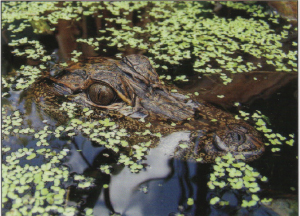A LITTLE PIECE OF HISTORY | By Joan Frances Images from American Alligator the Southern United States –

An adult American alligator.
The year 2016 is proving to be historical for the Fort Bend County community. For the first time since 1957, the Brazos River crested and overflowed to a record level, flooding areas of Richmond and Rosenberg. This natural disaster made national news for weeks. Not only has this been devastating for homeowners, but animals have suffered as well. Ranch horses, sheep and cows have struggled to find higher ground. Wild, native creatures have been forced to relocate to the most unlikely places, making it dangerous for residents to walk or swim in rising waters. One intimidating animal, a common sight in overflowing Fort Bend rivers that is protected by the Endangered Species Act of 1973, is the alligator.
Known as a living fossil, the alligator has existed for over 200 million years and is virtually unchanged in physical form. Alligators live in marshes, rivers, swamps and lakes anywhere west to California, south to Texas and north to Arkansas. There are about 23 species of the extant crocodilian ranging in size from five to 20 feet long and from 500 to 1,000 pounds. The creatures have a life span ranging from 35 to 50 years.
The American alligator, or Alligator mississippiensis, is semi-aquatic, has a dark, olive brown to black body and a broad, round snout with rows of raised scales along the back and tail. Its front feet have five toes, while its rear feet have four webbed toes. American alligators are carnivorous with a diet consisting of fish, amphibians, reptiles, birds and mammals and are known to be scavengers.

An adult American alligator skull.
An agile swimmer, the alligator often swims with only its eyes and nostrils exposed. It is active both day and night and can be seen floating on the surface of the water or basking on the shoreline. Females produce 20 to 50 eggs with an average incubation period of 65 days. Baby alligators stay with their mother for up to three years.

A juvenile American alligator hiding among duckweed.
Often mistaken for a large tree branch floating on the water, alligators are quick to move, and according to the Texas Parks and Wildlife Department, they can run up to 35 miles per hour on land but only in short bursts. Joggers, bikers and walkers along the bayou and at Brazos State Park are warned to watch out for alligators. Visitors like to observe them from the safety of boardwalks, bridges and trails. At Brazos State Park, it is estimated that around 250 alligators over six feet long reside in the 1,000 acres of water. They have lived in the Brazos Bend area for the past 65 million years. Alligators should never be fed by park administrators or visitors, because doing so teaches them to be unafraid of humans.
Because alligators are cold blooded, they use food mainly for growth, rep-air and reproduction. They could probably go for a year or so without eating if necessary. During the winter, they may not eat at all. Depending on their activity level and the water temperature, they can stay underwater from one to 24 hours.
The American alligator usually avoids humans, but as the population increases in Fort Bend County, there have been documented encounters with these massive animals. During flooding, they are capable of traveling far distances with the flow of the current, showing up in a swimming pool or backyard, but alligator attacks are rare.
Alligators are an important component of Fort Bend’s natural history and have an integral function in many wetland ecosystems. Thanks to the Texas law that provides complete protection for the alligator, this reptile will continue to be a part of our past and future history.